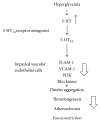Serotonin and Its Receptor as a New Antioxidant Therapeutic Target for Diabetic Kidney Disease
- PMID: 28929122
- PMCID: PMC5591914
- DOI: 10.1155/2017/7680576
Serotonin and Its Receptor as a New Antioxidant Therapeutic Target for Diabetic Kidney Disease
Abstract
Diabetic kidney disease (DKD) is a widespread chronic microvascular complication of diabetes mellitus (DM), affects almost 30-50% of patients, and represents a leading cause of death of DM. Serotonin or 5-hydroxytryptamine (5-HT) is a multifunctional bioamine that has crucial roles in many physiological pathways. Recently, emerging evidence from experimental and clinical studies has demonstrated that 5-HT is involved in the pathogenesis of diabetic vascular complications. The 5-HT receptor (5-HTR) antagonists exert renoprotective effects by suppressing oxidative stress, suggesting that 5-HTR can be used as a potential target for treating DKD. In this review, therefore, we summarize the published information available for the involvement of 5-HT and 5-HTR antagonists in the pathogenesis of various diabetic complications with a particular focus of DKD. We conclude that 5-HTR is a potential therapeutic target for treating DKD, as it has been successfully applied in animal models and has currently being investigated in randomized and controlled clinical trials.
Figures






Similar articles
-
Oxidative Stress and NRF2/KEAP1/ARE Pathway in Diabetic Kidney Disease (DKD): New Perspectives.Biomolecules. 2022 Sep 2;12(9):1227. doi: 10.3390/biom12091227. Biomolecules. 2022. PMID: 36139066 Free PMC article. Review.
-
Research advance in the mechanism for oxidative stress-induced podocyte injury in diabetic kidney disease.Zhong Nan Da Xue Xue Bao Yi Xue Ban. 2021 Dec 28;46(12):1403-1408. doi: 10.11817/j.issn.1672-7347.2021.210199. Zhong Nan Da Xue Xue Bao Yi Xue Ban. 2021. PMID: 35232911 Free PMC article. Chinese, English.
-
Targeting Mitochondria and Reactive Oxygen Species-Driven Pathogenesis in Diabetic Nephropathy.Rev Diabet Stud. 2015 Spring-Summer;12(1-2):134-56. doi: 10.1900/RDS.2015.12.134. Epub 2015 Aug 10. Rev Diabet Stud. 2015. PMID: 26676666 Free PMC article. Review.
-
Carbamylated Erythropoietin Alleviates Kidney Damage in Diabetic Rats by Suppressing Oxidative Stress.Curr Med Sci. 2021 Jun;41(3):513-521. doi: 10.1007/s11596-021-2370-x. Epub 2021 Jun 15. Curr Med Sci. 2021. PMID: 34129202
-
Iron Metabolism and Ferroptosis in Diabetic Kidney Disease.Cell Biochem Funct. 2025 Apr;43(4):e70067. doi: 10.1002/cbf.70067. Cell Biochem Funct. 2025. PMID: 40166850 Review.
Cited by
-
Huangkui capsules regulate tryptophan metabolism to improve diabetic nephropathy through the Keap1/Nrf2/HO-1 pathway.Front Pharmacol. 2025 Apr 30;16:1535352. doi: 10.3389/fphar.2025.1535352. eCollection 2025. Front Pharmacol. 2025. PMID: 40371325 Free PMC article.
-
Serotonin regulation of mitochondria in kidney diseases.Pharmacol Res. 2024 May;203:107154. doi: 10.1016/j.phrs.2024.107154. Epub 2024 Mar 22. Pharmacol Res. 2024. PMID: 38521286 Free PMC article. Review.
-
SGLT2 inhibitors improve kidney function and morphology by regulating renal metabolic reprogramming in mice with diabetic kidney disease.J Transl Med. 2022 Sep 14;20(1):420. doi: 10.1186/s12967-022-03629-8. J Transl Med. 2022. PMID: 36104729 Free PMC article.
-
A Systems Biology Approach to Investigating the Interaction between Serotonin Synthesis by Tryptophan Hydroxylase and the Metabolic Homeostasis.Int J Mol Sci. 2021 Feb 28;22(5):2452. doi: 10.3390/ijms22052452. Int J Mol Sci. 2021. PMID: 33671067 Free PMC article.
-
The role of microbial metabolites in diabetic kidney disease.Heliyon. 2023 Jul 4;9(7):e17844. doi: 10.1016/j.heliyon.2023.e17844. eCollection 2023 Jul. Heliyon. 2023. PMID: 37539130 Free PMC article.
References
Publication types
MeSH terms
Substances
LinkOut - more resources
Full Text Sources
Other Literature Sources
Medical

